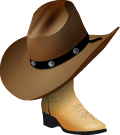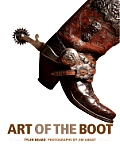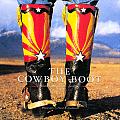|
Thinking of a Pair of Cowboy Boots for Your Wrangler?
-
Make Sure They Fit!
Cowboy boots, together with the hat are the most identifiable part of the cowboy's or cowgirl's dress.

Like the remainder of the dress, the design of cowboy boots is functional.
Cowboys in the Southwest saw the boots used by Mexican vaqueros, whose riding attire had been inherited from the Spanish Conquistadors.
The narrow, pointed toe and the smooth leather sole allows the boot to slip quickly into the stirrup while the high heel prevents the cowboy's foot from sliding through. The extremely pointed toe is a 20th-century adaptation and is more of a statement of "style" than of practicality. A cowboy once remarked that the "very pointy" boots were excellent for stepping on a spider trapped in a corner but not good for much else.
For most riders either a slightly pointed boot or one with a rounded toe is fine but a slightly ponted does does make placing the foot in the stirrup easier.
The upper leather protects the leg from brush and thorns. Not having laces and not fitting tightly is intentional - a safety feature. In the event of a fall from the saddle, the foot is likely to slide out of the boot should the boot become caught in the stirrup.
|
But you can walk, and even dance, in a pair that are well broken in and of good fit. No matter how comfortable they are, cowboy boots were not made for running, nor should they be worn while replacing shingles on a wet roof. |
Just as cowboys originally wore whatever clothing, hats or boots that were available, it was during the cattle drives after the Civil War that the requirements for a good riding book began to take form. With the British Wellington, the boots worn by the vaqueros, and the U.S. Cavalry footwear as models, the American cowboy began to craft a boot meeting their own special needs.
Wrinkles on the vamp (the part that goes over the top of the foot) made the boot more flexible and comfortable. As boots were used not only in work but for dress, ornamentation became more and more fancy. As is the case with other elements of attire, like the cowboy belt buckle.
There are good brand names available.. Companies like Justin and Nocona have been around a long time and provide a wide selection of boots in both lower and high proce ranges. Tony Lama and Dan Post are well known and respected bootmakers. Lucchese, not always as well known, provides excellent boots in the higher price range.
Boot Sizes and Foot Measurement
If a pair of riding or cowboy boots is on your horse lover's gift list purchasing them from your local retailer gives you the greatest assurance of getting a proper fit (assuming of course they have the brand and/or style you're looking for). You're likely be here though because you don't have a retailer nearby or a wide enough selection to choose from or ordering over the internet is simply your best option.
Of course you'll want a pair that look sharp and/or are rugged enough for the task at hand - preferably both. Of equal importance, as is the case with hats and saddles, you want a good fit.
- If you already know the boot size, simply order that size. As with hats, sizes can vary a bit with brand. If the boot is the same make as a pair you (or your horse lover) already own, ordering by size should work. This might be your only option if your gift is to be a surprise.
(If in doubt, it would not hurt to go a half-size higher). - If you don't know the size, you can guess. This isn't a recommended option unless you know several horse lovers and your purchase might happen to fit one of them.
There's probably no good answer to providing accurate foot measurments if you want the boots to be a surprise. You could try it if your horse lover is a very sound sleeper (and sleeps with socks on!). - Measure the feet; both of them and with boot socks on. Your gift won't be a surprise but well fitting boots will likely be greatly appreciated. You can convert length and width to standard USA or European foot size (click here to go to our Boot Size Chart).
Use the larger of the two feet for the conversion. If both feet measure exactly the same you're not abnormal, but for most folks one foot is slightly larger than the other. - You can also give the foot measurements to the retailer. They'll have a chart to convert to size, and it might not hurt to give them a phone call to make sure they get it right. A foot tracing, again both feet with socks wil also work. This is really a necessity if you're ordering a pair of custom-made boots. You would mail the tracing to the bootmaker.
If you elect the 3rd or 4th option, measure the feet around mid-day. If you measure your feet first thing in the morning, the boots you buy will be too small; boots will stretch a bit (in width, not length), but not that much nor that quickly.
The most accurate way to measure the foot is using one of the measuring tools found in shoe stores which automatically provide the size information. If you don't have one of these around the house (who does?), just place the foot snugly between two blocks or bricks, and then measure the distance between the blocks (for both length and width). You don't get the size but like with the hat, it's the accurate foot measurement that's important here. (Hope you don't mind us repeating that).
Feet often differ in size, up to a half size difference. Order the larger size. If the difference is more than a half size you may need to purchase custom-made boots.
And, like cowboy hats, if you seem to be in-between sizes, go for the higher size. If cowboy boots are a little large you can do something about it ( like heavier socks), but if they are a tad too small, too bad.
Brands and Price Range
I'll make no specific recommendation except to say that I've been satisfied with the Justin Ropers and Nocoma mid-priced boots I've owned. One pair of my Nocoma's are approaching 20 years old and while they look it they're still servicable and very comfortable.
Dan Post and Lucchese
boots are a step up in price, $200 and up although you may find a few styles closer to $100. If $500 to $1000 and up are within your budget, there are the custom boots.
A custom boot maker will almost always insist on having accurate foot measurements on hand before even considering starting construction of a boot. Also, with the custom boot maker, like the custom saddle maker, you may find yourself on a waiting list - but its probably worth it.
If you are considering a pair of custom made cowboy boots, three bootmakers who have established pretty fair reputations over the years are:
- El Paso-based
Champion Attitude Boots,
- D.W.Fromer II out of Oregon (an interesting web site by the way), and
- Mercedes Cowboy Boots of Fort Worth, Texas.
- D.W.Fromer II out of Oregon (an interesting web site by the way), and
Visiting their web-sites will give you a good perspective as to what's involved in ordering custom-made cowboy boots on-line, and probably give you a warmer feeling that it can be done successfully.
An Alternative for a Gift Idea


Boots take on a certain personality as they age and are often the most well-worn and personalized item a cowboy owns. If your horse lover is like me, he or she may have several pair of boots, one pair of which is definitely the most worn and tattered (and loved) and worn 95% of the time.
If this is the case, one of these books about boots might be as warmly received as another pair of boots. If you feel this might be the case, clicking on any of the titles will take you to the approprate page at Powells where you'll find more information.
The Art of the Boot by Tyler Beard is a guide to the artisans and manufacturers of America's classic footwear.
In David Stoecklein's The Cowboy Boot the photographs tell a different story for each pair. The text traces the evolution of the cowboy boot from its early influences to present-day fashion trends.
If you don't find an idea for a great horse lover's gift here there's always a Good Horse Book, an item of fine Equine Jewelry, or for something a little out of the ordinary see our Cool Ideas for Horse Lover Gifts page
- or pay a visit to our Gift Shop.
Back to Your Guide to Gifts for Horse Lovers Home Page

